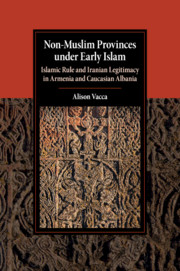 Non-Muslim Provinces under Early Islam
Non-Muslim Provinces under Early Islam Book contents
- Frontmatter
- Dedication
- Contents
- List of Illustrations
- Acknowledgments
- Situating Places, People, and Dates
- 1 Non-Persian Provinces of Iran, Non-Muslim Provinces of Islam: An Introduction to the Umayyad and ʿAbbāsid North
- 2 Whence the Umayyad North?: Byzantine, Sasanian, and Caliphal Administrative Geography of the North
- 3 Lost Greek Kings and Hoodwinked Khazars: Sasanian and Byzantine Legacy in the Construction of Caliphal Frontiers in the North
- 4 The So-Called Marzb ā ns and the Northern Freemen: Local Leadership in the North from Sasanian to Caliphal Rule
- 5 Caliphs, Commanders, and Catholicoi: Mechanisms to Control the North under Byzantine, Sasanian, and Caliphal Rule
- 6 Taxing the Dead and Sealing the Necks of the Living: Sasanian and Caliphal Treaties and Taxation in the North
- 7 Collective Historical Amnesia: The Case for a Parthian Intermezzo
- Bibliography
- Index
- Miscellaneous Endmatter
7 - Collective Historical Amnesia: The Case for a Parthian Intermezzo
Published online by Cambridge University Press: 08 September 2017
- Frontmatter
- Dedication
- Contents
- List of Illustrations
- Acknowledgments
- Situating Places, People, and Dates
- 1 Non-Persian Provinces of Iran, Non-Muslim Provinces of Islam: An Introduction to the Umayyad and ʿAbbāsid North
- 2 Whence the Umayyad North?: Byzantine, Sasanian, and Caliphal Administrative Geography of the North
- 3 Lost Greek Kings and Hoodwinked Khazars: Sasanian and Byzantine Legacy in the Construction of Caliphal Frontiers in the North
- 4 The So-Called Marzb ā ns and the Northern Freemen: Local Leadership in the North from Sasanian to Caliphal Rule
- 5 Caliphs, Commanders, and Catholicoi: Mechanisms to Control the North under Byzantine, Sasanian, and Caliphal Rule
- 6 Taxing the Dead and Sealing the Necks of the Living: Sasanian and Caliphal Treaties and Taxation in the North
- 7 Collective Historical Amnesia: The Case for a Parthian Intermezzo
- Bibliography
- Index
- Miscellaneous Endmatter
Summary
This book establishes several main points about the memory of eighth- and ninth-century caliphal rule in Armenia and Caucasian Albania. First, we cannot understand caliphal rule in Armenia and Albania without reference to the regions’ ties to Iran. The North was part of the Iranian oikoumene, a diverse cultural zone that shared certain perceptions of the past and expressions of legitimacy. Second, Arabic and Armenian sources suggest that caliphal rule in the North, like elsewhere in the Iranian oikoumene, was understood as a continuation of Sasanian norms. In particular, Khurāsān presents a productive point of comparison. Third, many of our sources on both Sasanian and caliphal rule in the North were written in the tenth century during the Iranian intermezzo, which colors how these authors described legitimacy and power. Since tenth-century kings and amīrs across the Iranian oikoumene (including the North) claimed to be shāhanshāhs, the description of Sasanian and caliphal rule based on this model may say more about the tenth century than about the eighth or ninth centuries. Finally, the position of Armenia and Albania along the Byzantine and Khazar frontiers also informed the Arabic and Armenian descriptions of the North. Claiming continuity meant staking a claim in hotly contested territories precisely at the moment when Byzantium was making inroads against the North in the tenth century.
All of this suggests that administrative continuity from Sasanian to caliphal rule was a perception, not a reality. If we had to speak of the caliphal North wie es eigentlich gewesen, we have seen indications, first, that the Marwānid Reforms challenge significantly any suggestion of administrative continuity. Second, caliphal rule was decentralized with considerable independence of the local élite, even allowing for intermittent centralizing policies. Third, caliphal rule was a combination of Byzantine, Sasanian, and local practices. The élite maneuvered through the tangle of conflicting local inheritances in order to take what worked and to refashion it based on their own needs. Finally, in this, the administrative and cultural contact (both Muslim and Christian) between Armenia and Mesopotamia was central, if rarely explicitly mentioned in our sources.
- Type
- Chapter
- Information
- Non-Muslim Provinces under Early IslamIslamic Rule and Iranian Legitimacy in Armenia and Caucasian Albania, pp. 210 - 224Publisher: Cambridge University PressPrint publication year: 2017
